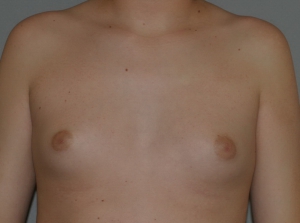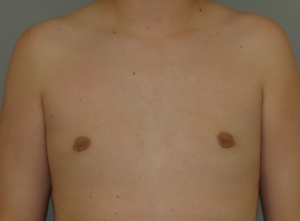Gynecomastia: Male Breast Reduction
Gynecomastia is a condition that causes excess fat growth and enlarged breast size in men. This condition can affect men of all ages, sizes, and weight. This can commonly impact both breasts (bilateral); however, some men do experience this on one side only (unilateral). Gynecomastia impacts many men, and while the cause is occasionally unknown, some conditions can exacerbate this issue. These causes include:
- Obesity
- Steroid or other drug use
- Hormonal imbalances
- Heredity
Dr. Behmand offers male breast reduction as a solution for patients who have gynecomastia. Surgeons design this procedure to remove glandular tissue and excess fat from the breast area. The result is a firmer, flatter, and more traditionally masculine-looking chest.
Candidates for Male Breast Reduction
The best candidates for male breast reduction include:
-
- Healthy men
- Men that are of a normal weight
- This procedure is necessary for men whose breast size cannot be reduced by means besides surgery
- Men that do not use drugs or steroids
- Men who have struggled with large breasts for an extended period of time
- Young men or adults that suffer from bullying or taunting due to the size of their breasts
Because of the many causes of gynecomastia, Dr. Behmand will discuss lifestyle changes that may naturally reduce the amount of existing breast tissue during the initial consultation.
Obese patients should first attempt to lose weight through exercise and diet. Certain drugs, such as anabolic steroids, can also cause gynecomastia. Before attempting male breast reduction, discontinue the use of these substances.
FAQ’s
-
Q: What is gynecomastia?
- A: Gynecomastia is a male breast reduction surgery. Surgeons perform this procedure for men who have developed excess breast tissue on one or both breasts, commonly due to fluctuations in hormones or weight gain. Patients with gynecomastia cannot lose the excess breast tissue with weight-loss.
-
Q: Who is a suitable candidate for gynecomastia?
- A: Any male patient who has excessive breast growth on one or both breasts, and who is also in generally good health.
-
Q: Can gynecomastia be covered by my insurance?
- A: In the majority of patients, this procedure is considered elective, and insurance will not cover this procedure.
-
Q: What will my recovery be like?
- A: Most patients prefer to take 1 to 2 weeks off work for their recovery. You will also have physical restrictions for at least 4 to 6 weeks following surgery. During this time, you cannot exercise, go to the gym, or engage in any strenuous activity. You will need to minimize your arm movements as well, to help optimize recovery (no lifting, pulling, or stretching).
The Male Breast Reduction Procedure
Depending on the type and amount of breast tissue present, Dr. Behmand may use one of two male breast reduction techniques. If the gynecomastia is caused mostly by excess fat, Dr. Behmand will be able to treat the condition using only liposuction. Through a tiny incision, he will suction out the fat with a small tube called a cannula. This will leave a small incision that will go unnoticed to the untrained eye.
Dr. Behmand will generally use an incision around the lower half of the areola (nipple) to surgically remove excess breast tissue caused by both glandular tissue and fatty deposits. He will then use liposuction to remove and contour the excess fatty tissue. Again, the incisions will be small and, while slightly more noticeable at first, will typically start to lighten and fade dramatically with proper postoperative care of the incisions. In more advanced cases of gynecomastia, it may be necessary to remove excess skin along with the excess fat and breast tissues. This type of operation typically requires additional incisions, often in the crease under the breast.
After Your Male Breast Reduction Surgery
Shortly after the male breast reduction procedure, you will be released home to begin recovery in the comfort of your surroundings.
After surgery, you might experience moderate bruising and swelling in the chest area. You will be provided with a post-surgical compression garment, which looks similar to a man’s undershirt and typically is easily concealed under your normal clothing. This garment will help to reduce swelling and improve final chest contour while making recovery more comfortable.
Some mild discomfort for the first few days after surgery is normal, so we do ask that you remain off work or school for approximately one week after the procedure for optimal comfort. Most bruising and swelling will subside after two weeks or so, with the majority of the swelling gone at six weeks after the operation. During your consultation with Dr. Behmand, he’ll be able to give you specific post-operative instructions that will help make your gynecomastia treatment a success.
If you suffer from gynecomastia, we encourage you to contact our office today for a consultation with Dr. Behmand.











